As the world reaches 8 billion people, we at UNFPA see India’s 1.4 billion people as 1.4 billion opportunities.
India’s story is a powerful one. It is a story of progress in education, public health and sanitation, economic development as well as technological advancements. As the country with the largest youth cohort—its 254 million youth (15-24 years) can be a source of innovation, new thinking and lasting solutions. The trajectory can leapfrog forward if women and girls in particular are equipped with equal educational and skill building opportunities, access to technology and digital innovations, and most importantly with information and power to fully exercise their reproductive rights and choices.
Ensuring gender equality, empowerment and advancing greater bodily autonomy for women and girls—is one of the key determinants of a sustainable future. Individual rights and choices should be respected, and all should be able to decide when to have children, if any, and how many.
Women and girls should be at the centre of sexual and reproductive policies and programmes. Adopting a ‘life-cycle’ approach, where girls and women are empowered at every stage of their lives, gender responsive work arrangements (for both men and women) that enable women to continue engagement in decent work opportunities in the long run, reducing barriers within the workplace, and improved access to finance will allow women and girls to pursue their life-time aspirations and harness untapped potential.
When rights, choices and equal value of all people are truly respected and held, only then can we unlock a future of infinite possibilities.
As part of the SWOP 2023, a public survey was commissioned by UNFPA and conducted by YouGov, which asked a representative sample of 7,797 people across eight countries (India, Brazil, Egypt, France, Hungary, Japan, Nigeria, and the United States) for their views on population issues. For India, the total sample size was 1,007 and the survey was carried out online. The analysis has been weighted and is representative of a national urban sample of adults in India (aged 18+). Key India insights from State of the World Population Report (SOWP) 2023:
● On identifying the population-related matters of greatest importance, 63 per cent Indians identified various economic issues as the top concerns when thinking about population change, followed by environmental concerns (46 per cent), and sexual and reproductive health and rights and human rights concerns (30 per cent).
● Respondents in India held the opinion that the population in their country was too large and fertility rates too high. There was no significant difference between the views of men and women in India on national fertility rates.
The Indian survey findings suggest that population anxieties have seeped into large portions of the general public. Yet, population numbers should not trigger anxiety or create alarm. Instead, they should be seen as a symbol of progress, development, and aspirations if individual rights and choices are being upheld.
Global experience has shown that family planning targets can lead to gender-based discrimination and other harmful practices.
Deleterious effects of such targets include prenatal sex determination leading to sex selective abortion and imbalanced sex ratios, preferential health and nutrition for male children, denial of the paternity of female children, violence against women for giving birth to girl children, and coercion of women to have fewer or greater numbers of children.
In 2021, the national Government of India emphasised its opposition to coercion in family planning, and stated in several fora, including in Parliament, that it did not condone such policies, as they would prove to be “counter- productive.”
With close to 50 per cent of its population below the age of 25, India has a time-bound opportunity to benefit from the demographic dividend. As the national fertility rate falls below 2.1 (the replacement level), India is at a unique historical opportunity, witnessing a great demographic transition as youthful nation, with a notable demographic diversity across states to convert the potential demographic dividend into economic benefits through additional investments in health, education, and quality jobs for young people - including targeted investments in women and girls. India’s demographic dividend can be further secured by incorporating the impact of mega trends such as climate change, urbanisation, migration and ageing into policy initiatives.
(As published on Outlook, the author is Andrea M. Wojnar, Representative UNFPA India and Country Director Bhutan)


